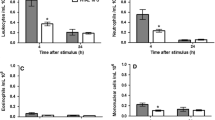Abstract
Objective and design
To determine whether exposure to E. coli lipopolysaccharide (LPS) modulates adenosine A1 receptor-induced increase in plasma exudation from the intact hamster cheek pouch microcirculation.
Methods and results
Using intravital microscopy, we found that suffusion of R(−)-N 6-(2-phenylisopropyl)-adenosine (R(−)-PIA) (1.0 and 10.0 nM), a selective adenosine A1 receptor agonist, onto the intact cheek pouch elicited significant, concentration-dependent leaky site formation and increase in clearance of fluorescein thioisocyanate-dextran (mol mass, 70 kDa) from post-capillary venules (p < 0.05). These responses were significantly attenuated by pre-treatment of hamsters with LPS (p < 0.05). By contrast, LPS had no significant effects on CGS-21680-, a selective adenosine A2A receptor agonist, bradykinin- and substance P-induced increases in plasma exudation from the cheek pouch.
Conclusion
These data indicate that LPS attenuates adenosine A1 receptor-induced increase in plasma exudation in vivo in a specific fashion. We suggest that this phenomenon represents an endogenous anti-inflammatory cue to avoid excessive inflammation during Gram-negative bacterial infections.



Similar content being viewed by others
References
Matsuda T, Eccleston CA, Rubinstein I, Rennard SI, Joyner WL. Antioxidants attenuate endotoxin-induced microvascular leakage of macromolecules in vivo. J Appl Physiol. 1991;70:1483–9.
Cronstein BN, Daguma L, Nichols D, Hutchison AJ, Williams M. The adenosine/neutrophil paradox resolved: human neutrophils possess both A1 and A2 receptors that promote chemotaxis and inhibit O2 − generation, respectively. J Clin Invest. 1990;85:1150–7.
Gallos G, Ruyle TD, Emala CW, Lee HT. A1 adenosine receptor knockout mice exhibit increased mortality, renal dysfunction, and hepatic artery injury in murine septic peritonitis. Am J Physiol. 2005;289:F369–76.
Heller AR, Rothermel J, Weigand MA, Plaschke K, Schmeck J, Wendel M, et al. Adenosine A1 and A2 receptor agonists reduce endotoxin-induced cellular energy depletion and oedema formation in the lung. Eur J Anaesthesiol. 2007;24:258–66.
Le Moine O, Quertinmont E, Gulbis B, Devière J. Blunted anti-inflammatory response to adenosine in alcoholic cirrhosis. J Hepatol. 1999;31:457–63.
Rubinstein I, Chandiwala R, Dagar S, Hong D, Gao X-p. Adenosine A1 receptors mediate plasma exudation from the oral mucosa. J Appl Physiol. 2001;91:552–60.
Neely CF, Jin J, Keith IM. A1-adenosine receptor antagonists block endotoxin-induced lung injury. Am J Physiol. 1997;272:L353–61.
Schrier DJ, Lesch ME, Wright CD, Gilberstein RB. The anti-inflammatory effects of adenosine receptor agonists on the carrageenan-induced pleural inflammatory response in rats. J Immunol. 1990;145:1874–9.
Akhter SR, Gao X-p, Ikezaki H, Rubinstein I. Dexamethasone attenuates grain sorghum dust-induced increase in macromolecular efflux in vivo. J Appl Physiol. 1999;86:1603–9.
Gao X-p, Robbins RA, Snider RM, Lowe J III, Rennard SI, Anding P, et al. NK1 receptors mediate tachykinin-induced increase in microvascular clearance in hamster cheek pouch. Am J Physiol. 1993;265:H593–8.
Yong T, Gao X-p, Koizumi S, Conlon JM, Rennard SI, Mayhan WG, et al. Role of peptidases in bradykinin-induced increase in vascular permeability in vivo. Circ Res. 1992;70:952–9.
Gawlowski DM, Durán WN. Dose-related effects of adenosine and bradykinin on microvascular permeability to macromolecules in the hamster cheek pouch. Circ Res. 1986;58:348–55.
Gawlowski DM, Benoit JN, Granger HJ. Microvascular pressure and albumin extravasation after leukocyte activation in hamster cheek pouch. Am J Physiol. 1993;264:H541–6.
Tomeo AC, Durán WN. Resistance and exchange microvessels are modulated by different PAF receptors. Am J Physiol. 1991;261:H1648–52.
Bruno VA, Scacchi PA, Perez-Lloret S, Esquifino AI, Cardinali DP, Cutrera RA. Melatonin treatment counteracts the hyperthermic effect of lipopolysaccharide injection in the Syrian hamster. Neursci Lett. 2005;389:169–72.
Memon RA, Fuller J, Moser AH, Feingold KR, Grunfeld C. In vivo regulation of plasma platelet-activating factor acetylhydrolase during the acute phase response. Am J Physiol. 1999;277:R94–103.
Wilson CN, Batra VK. Lipopolysaccharide binds to and activates A1 adenosine receptors on human pulmonary artery endothelial cells. J Endotoxin Res. 2002;8:263–71.
Ruiz MA, Albasanz JL, León D, Ros M, Andrés A, Martin M. Different modulation of inhibitory and stimulatory pathways mediated by adenosine after chronic in vivo agonist exposure. Brain Res. 2005;1031:211–21.
León D, Albasanz JL, Ruíz MA, Martín M. Chronic caffeine or theophylline intake during pregnancy inhibits A1 receptor function in the rat brain. Neuroscience. 2005;131:481–9.
Rebola N, Porciuncula LO, Lopes LV, Oliviera CR, Soares-da-Silva P, Cunha RA. Long-term effect of convulsive behavior on the density of adenosine A1 and A2ª receptors in the rat cerebral cortex. Epilepsia. 2005;46(Suppl 5):159–65.
Conti A, Loza G, Monopoli A. Prolonged exposure to 5′-N-ethylcarboxamidoadenosine [NECA] does not affect the adenosine A2A-mediated vasodilation in porcine coronary arteries. Pharmacol Res. 1997;35:123–8.
Ramkumar V, Olah ME, Jacobson KA, Stiles GL. Distinct pathways of desensitization of A1- and A2-adenosine receptors in DDT1MF-2 cells. Mol Pharmacol. 1991;40:639–47.
Tao P-L, Liu C-F, Tsai H-C. Chronic intracerebroventricular administration of morphine down-regulates spinal adenosine A1 receptors in rats. Eur J Pharmacol. 1995;278:233–7.
Murphree LJ, Sullivan GW, Marshall MA, Linden J. Lipopolysaccharide rapidly modifies adenosine receptor transcripts in murine and human macrophages: role of NF-κB in A2A adenosine receptor function. Biochem J. 2005;391:575–5580.
Murray MA, Heistad DD, Mayhan WG. Role of protein kinase C in bradykinin-induced increase in microvascular permeability. Circ Res. 1991;68:1340–8.
Rubinstein I, Potempa J, Travis J, Gao X-p. Mechanisms mediating Porphyromonas gingivalis gingipain RgpA-induced oral mucosa inflammation in vivo. Infect Immun. 2001;69:1199–201.
Miller FN, Joshua IG, Anderson GL. Quantitation of vasodilator-induced macromolecular leakage by in vivo fluorescent microscopy. Microvasc Res. 1982;24:56–67.
Warren JB, Wilson AJ, Loi RK, Coughlan ML. Opposing roles of cyclic AMP in the vascular control of edema formation. FASEB J. 1993;7:1394–400.
Acknowledgments
This study was supported in part by NIH Grants RO1 AG024026 and RO1 HL72343, and by VA Merit Review.
Author information
Authors and Affiliations
Corresponding author
Additional information
Responsible Editor: Makoto Katori.
Rights and permissions
About this article
Cite this article
Gao, Xp., Rubinstein, I. E. coli lipopolysaccharide attenuates adenosine A1 receptor-mediated increase in plasma exudation from the hamster cheek pouch. Inflamm. Res. 60, 195–201 (2011). https://doi.org/10.1007/s00011-010-0254-9
Received:
Revised:
Accepted:
Published:
Issue Date:
DOI: https://doi.org/10.1007/s00011-010-0254-9




